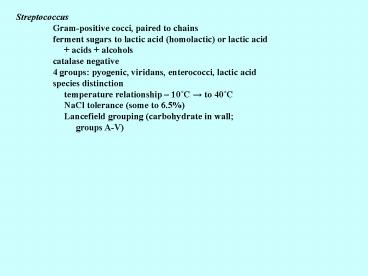Streptococcus - PowerPoint PPT Presentation
1 / 17
Title:
Streptococcus
Description:
coagulase positive - S. aureus. coagulase negative (CNS) - 30 species ... food poisoning. onset 30 min to 7 hr, duration 24 hr. abrupt onset: severe nausea and cramps ... – PowerPoint PPT presentation
Number of Views:159
Avg rating:3.0/5.0
Title: Streptococcus
1
Streptococcus Gram-positive cocci, paired to
chains ferment sugars to lactic acid
(homolactic) or lactic acid acids
alcohols catalase negative 4 groups pyogenic,
viridans, enterococci, lactic acid species
distinction temperature relationship 10C
? to 40C NaCl tolerance (some to 6.5)
Lancefield grouping (carbohydrate in wall
groups A-V)
2
Group A - pyogenic S. pyogenes acute
infections Group B - major sepsis in
newborns post-partum infections in women Group
D - enterococci bowel flora, opportunists now
separate genus Viridans - normal oral
flora Pneumococcus - S. pneumoniae no
Lancefield antigen capsular antigen acute lung
inflammation acute bacterial meningitis (age 15
older)
3
Virulence factors M protein - Group A
antiphagocytic factor causes rapid
destruction of C3b C5a peptidase - Group A
C5a attracts phagocytes activates them F
protein - Group A pneumococcus binds
fibronectin on host cells helps bacteria
evade immune system capsules - S.
pneumoniae, complex polysaccharide
antiphagocytic - hyaluronic acid,
associated with rheumatic fever role? -
dextran IgA protease - S. pneumoniae,
importance?
4
Virulence factors Pneumolysin - binds
cholesterol pore in cell membrane released
on cell death causes inflammation, the
cause of symptoms/signs Erythrogenic toxin -
causes TSS-like syndrome
superantigen Exfoliatin - triggers inflammatory
response tissue damage Streptolysin O -
pore former enhanced by erythrogenic
toxin cause of rheumatic heart damage
5
Streptococcal diseases 1. pneumonia
a. colonization of pharynx b. by-pass
clearance mechanisms get to lung c1.
escape phagocytosis c2. induce
inflammation c3. damage endothelial
cells inflammatory response bacterial
cell components activate complement
macrophages neutrophils drawn in blood
vessels become leaky bacteria pass to blood
stream, attach to blood vessels in
brain spinal cord damage to blood vessels
due to complement and other
chemicals meningitis may result
6
2. strep throat bacteria adhere to
throat (F protein, cell wall
components) inflammatory response
(bacterial enzymes toxins) cell wall
components trigger complement cascade
scarlet fever - strep throat plus rash
3. rheumatic fever glomerulonephritis
bacteria in throat lyse due to inflammatory
response wall fragments trigger antibody
response RF antibodies to M protein cross react
with proteins on cardiac muscle
T lymphocytes attack, inflammatory response
occurs heart valves damaged Glom
antibodies complex with bacterial components in
blood complexes accumulate in
kidney inflammatory response damages kidney
7
4. necrotizing fasciitis infections
mixed S. pyogenes most serious high
mortality skin, fascia, muscles,
septicemia extensive tissue damage,
necrosis 5. superficial impetigo
thick, adherent lesions with dirty yellow crust
highly contagious
8
6. erysipelas and cellulitis skin is
erythematous, edematous and tender
Cellulitis Erysipelas
9
Staphylococcus Gram-positive cocci, irregular
clusters yellow to orange pigment
produced facultative anaerobes catalase
positive inhabitants of skin, skin glands, nasal
mucosa of homeotherms some pathogens -
coagulase distinction coagulase positive - S.
aureus coagulase negative (CNS) - 30 species
commensals but some may cause infections
S. epidermidis most frequent isolate distinction
from S. aureus coagulase mannitol
fermentation pigmentation
10
S. aureus infections boils, furuncles, bullous
impetigo, pneumonia, osteomyelitis endocarditis,
meningitis nosocomial infections - catheters,
heart valves Virulence factors adherence
factors - surface proteins bind to host cells
(fibronectin, collagen, etc.) (indwelling
devices coat with host proteins) avoidance
factors - reduce phagocytosis toxins a-toxin
- monocytes and platelets sensitive forms pore
in cell membrane, releases cytokines which
cause inflammatory response may lead to septic
shock hypotension, hypoxia respiratory
failure, renal failure, intravascular
coagulation, hemorrhaging mortality 40-70
11
toxins a-toxin - sphingomyelinase ß-toxin
leukocidin act together - Panton Valentine
PV leukocidin induce inflammatory mediator
release enterotoxin- heat-stable food
poisoning diarrhea vomiting superantigen
exfoliatin - scalded skin syndrome in
neonates blistering and loss of epidermis
12
Staphylococcal diseases boils, furuncles,
carbuncles acute abcess of skin
subcutaneous tissues extreme tenderness
followed by swelling, pus formation, then
spontaneous draining wound infections
(primarily S. aureus) purulent drainage
associated factors age, steroid
administration, obesity, malnutrition,
diabetes, other infections breast infections -
mastitis generally in newborns and women
esp. after labor pain lump may be more
extensive
13
Staphylococcal diseases pneumonia a. lobar
pneumonia acute illness with high fever cough
with yellow bloody sputum containing cocci
neutrophils b. diffuse interstitial
pneumonia accompanied by or follows
pneumonia tachypnea cyanosis c.
localized areas of pneumonia secondary to
septic emboli with infarction bacteremia b
acteremia with endocarditis chest pain, fever,
chills, rapid breathing with pain
14
Staphylococcal diseases endocarditis
acute fulminant illness high fever
metastatic abcesses potential for lethal
damage to heart valves in prosthetic heart
valve cases - gt40 caused by CNS bacteremia -
from any site, often CNS high fever,
tachycardia, often shock blood coagulation
may occur underlying disease - diabetes,
leukemia
15
Staphylococcal diseases food poisoning
onset 30 min to 7 hr, duration 24 hr abrupt
onset severe nausea and cramps followed by
diarrhea, vomiting, prostration usually no
fever toxic shock syndrome fever,
erythematous macular rash which peels
falling blood pressure meningitis 1-9 of
all bacterial cases fever, stiff neck
16
Staphylococcal diseases scalded skin syndrome
abrupt onset with diffuse erythema skin
very sensitive to touch 1-2 days, begins to
peel with light touch
17
Treatment S. aureus resistant to most
antibiotics Methicillin was drug of choice now
MRSA common methicillin resistant also
resistant to many other antibiotics Vancom
ycin still effective, but resistance
appearing S. aureus resistant to some
antiseptics disinfectants survive in some
environments - hospital

